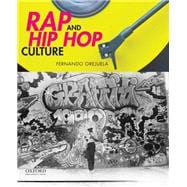Rap and Hip Hop Culture traces the ideological, social, historical, and cultural influences on a musical genre that first came to prominence in the mid-1970s in one of New York's toughest neighborhoods, the South Bronx. Orejuela describes how the arts of DJing, MCing, breakin' [b-boying], and graffiti developed as a way for this community's struggle to find its own voice. He addresses rap's early successes on the pop charts; its spread to mainstream culture; the growth of "gangsta rap" and mainstream society's reaction to it; and the commercial success of rap music from the '90s through today. Throughout, this enlightening text highlights key performers, producers, and voices in the rap and hip hop movements, using their stories to illuminate the underlying issues of racism, poverty, prejudice, and artistic freedom that are part of rap and hip hop's ongoing legacy.
Distinctive Features
* Traces the roots of rap and hip hop culture in African and African American history
* Designed for an introductory course in rap and hip hop for students with little or no background in music
* Includes 17 detailed listening guides covering key recordings in rap's history
* Addresses the many controversies surrounding rap music, including violence, sexism, and racial stereotyping
* Includes chapter outlines and goals, questions for further discussion and study, and key terms








